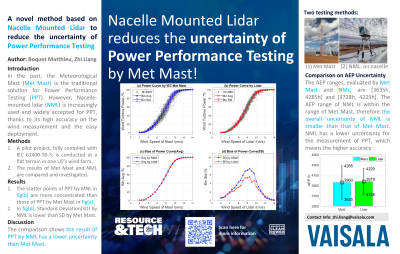Back

A novel method based on Wind Lidar to reduce the uncertainty of Power Performance Testing
Tuesday, October 1, 2024
5:00 PM – 6:00 PM MST
Location: Regency D

- MB
Matthieu Boquet
Head of Wind Operations BU
Vaisala
Poster Presenter(s)
Presentation Description: Nowadays, Wind Lidar is widely used for various wind-related applications in wind energy. For Power Performance Testing (PPT), one type of Wind Lidar is installed on and yawed with the turbine nacelle, which brings many advantages such as high measurement efficiency and low cost, especially in offshore. Traditionally, Meteorological Mast (Met Mast) is the standard approach, however, one recent research shows that the Met Mast affects the surrounding wind filed and adds uncertainty of the wind measurement and the PPT result (Shin et al., 2019).
One pilot project is conducted in United States to study the measurement accuracy of Met Mast and Wind Lidar. For the testing wind turbine, one Wind Lidar is mounted on the turbine nacelle and one Met Mast is located at 290 meters away from the turbine.
The result shows good measurements: the wind speed correlation coefficient between Wind Lidar and Met Mast is 0.994, with the slope and the offset of 0.979 and 0.084, respectively. The 10-min averaged scatters of Wind Lidar are more concentrated, and the uncertainty of PPT is lower. This phenomenon is because Wind Lidar measures the wind speed right ahead of the turbine rotor, which is more representative of the free wind speed.
The uncertainty is evaluated by assuming Weibull wind distribution and the AEP ranges of Met Mast and Wind Lidar are [3592h, 4265h] and [3739h, 4252h], respectively. The uncertainty range of Wind Lidar is within the range of Met Mast, which means the lower uncertainty and higher accuracy.
This study compares the accuracy of PPT by Wind Lidar and Met Mast and results show the lower uncertainty for PPT and AEP calculation using Wind Lidar. This study promotes the method of PPT based on Wind Lidar, which could reduce the uncertainty by Met Mast.
One pilot project is conducted in United States to study the measurement accuracy of Met Mast and Wind Lidar. For the testing wind turbine, one Wind Lidar is mounted on the turbine nacelle and one Met Mast is located at 290 meters away from the turbine.
The result shows good measurements: the wind speed correlation coefficient between Wind Lidar and Met Mast is 0.994, with the slope and the offset of 0.979 and 0.084, respectively. The 10-min averaged scatters of Wind Lidar are more concentrated, and the uncertainty of PPT is lower. This phenomenon is because Wind Lidar measures the wind speed right ahead of the turbine rotor, which is more representative of the free wind speed.
The uncertainty is evaluated by assuming Weibull wind distribution and the AEP ranges of Met Mast and Wind Lidar are [3592h, 4265h] and [3739h, 4252h], respectively. The uncertainty range of Wind Lidar is within the range of Met Mast, which means the lower uncertainty and higher accuracy.
This study compares the accuracy of PPT by Wind Lidar and Met Mast and results show the lower uncertainty for PPT and AEP calculation using Wind Lidar. This study promotes the method of PPT based on Wind Lidar, which could reduce the uncertainty by Met Mast.
